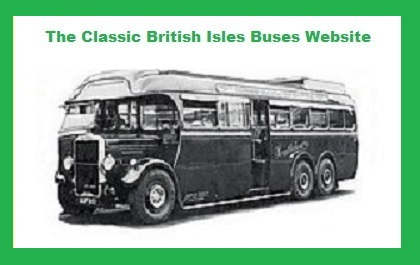

The Classic British Isles Buses Website
Dundee Corporation - photo album (by Dick Gilbert)
Last updated 23 August 2024
Email Events diary Past events list Classified ads Links to other websites Classic U.K. Buses Classic Irish Buses Classic Manx Buses
| Photo collection | Pre-war double deckers | Post-war double deckers | Single deckers | Miscellaneous pictures |
Another look at some delightful vehicles from the past. On this page we look at some of the older buses of Dundee Corporation, by courtesy of Nick Webster who supplied all the photographs and most of the text. Thanks very much Nick. And thanks also to Bruce Gauld and the late Iain Drummond (who sadly passed away in Australia in September 2004) for various pieces of additional information.
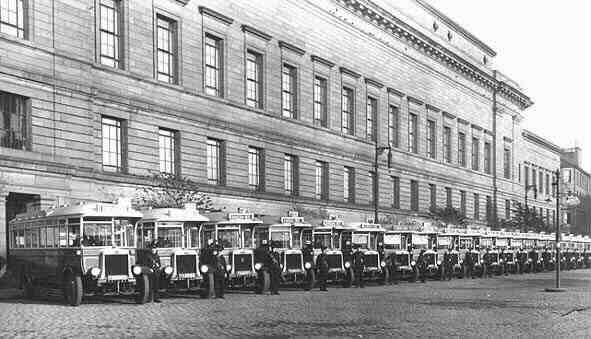
Quite what occasion has brought twenty Leyland Lions with drivers and conductors together is unknown to me. Dundee had bought seven in 1926 but I do not know when the others followed. Scrutiny of the original photograph reveals minor detail differences that denote changes during production and some of the buses are obviously not new. TS 6249 nearest the camera has been in service for a while and has a very worn nearside front tyre. It is also quite an early model, with an emblem on the radiator cap. All have Leyland standard bodywork. Although this photograph pre-dates all the others that follow it is such a magnificent sight that it makes a fitting introduction to this collection of bus images from Dundee.
Iain Drummond said: "The Leyland Lions were photographed outside the head office of the Corporation Transport Department. There were 28 of these bought new between 1928 and 1930. The building above the offices is the back of the Town Hall flanked by the Maryatt Hall and the Caird Hall. The buses were numbered 1-28 and are seen in Shore Terrace in the early 1930s before the bus stance was built between the Terrace and Dock Street. Opposite the buses would have been the Queen Victoria Arch and the Empress Ballroom."
David Craig says: "The twenty Leyland PLSC1 Lions lined up behind Caird Hall in Shore Terrace are, from left, bus numbers 1, 2, 8, 4, 5, 6, 7, 9, 10, 11, 12, 13, 14, 15, 16, 17, 18, 19, 20 and 3. The bus with the worn tyre, bus no. 1 (TS 6249) and bus no. 2 (TS 6250) were the first of these Lions to enter service which was on 1st January 1927. The remainder of the 1926-built original batch nos. 3-7 (TS 6251 - TS 6255) arrived on 7th January 1927. The next batch, 1927-built nos. 8-10 (TS 6915 - TS 6917) entered service on 10th October 1927. The third batch, also built in 1927, were nos. 11-14 (TS 6991 - TS 6994) and entered service on 18th January 1928. The final batch, nos. 15-20 (TS 7522 - TS 7527) and built in 1928 entered service on 8th August, 1928."
"The Transport Dept. offices were not located in the buildings behind the Lions. Originally they were sited in the old Town House in High Street and when that building was demolished they were relocated to 1 Lochee Road."
"Although there were eventually crew facilities on the ground floor of the Caird Hall building behind the Lions, I think this view is too early for these facilities to have been in use then. The photograph appears to have been taken before 1932 as by then the Lions had had their destination and route number boxes repositioned below the roofline and Shore Terrace did not come into use as the central terminus until 1933. (The photograph of No. 20 (TS 7527) in part (4) the single deckers shows the new position of the destination/route display which was in use by 1932."
"The other 8 Lions to which Iain Drummond referred to make the total 28 were of the later and quite different LT1 model. They entered service on 31.12.1929 (Nos. 21 - 26) and 1.2.1930 (Nos. 27 and 28). The Queen Victoria Arch also referred to by Iain Drummond was better known as the Royal Arch and the Empress Ballroom did not exist at the time that the photograph was taken. The wooden structure which became the ballroom was originally used at the 1938 Empire Exhibition in Glasgow and when the exhibition closed, was dismantled and re-erected in Dundee on the site next to the Royal Arch."
It is believed all of the following photographs were taken sometime around 1957-62. They are part of a collection owned by Nick Webster. The Dundee Corporation livery changed at about this time and differences will be noted on some vehicles. Many were delivered with extensive lining out, like the Lions above but sadly this had all disappeared by the time the photographs were taken. Unfortunately neither Dick Gilbert or Nick Webster have any first hand knowledge of the buses in this feature and would welcome additional information, particularly relating to where the photographs might have been taken.
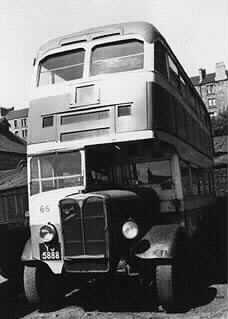
Very near the end of its life, YJ 5888 (no. 66) basks in the sun. It was a Weymann bodied 1938 Regent 1, chassis number O6615944. Indeed it might even have been de-licensed at this time because it is standing near a row of buses which have been partly stripped for spares. It was the second in a batch of four like this, numbered 65-68. All were withdrawn in 1957, which probably helps to date this picture. The script on the radiator shows that it was fitted with the A180 direct injection 8.8 litre engine. It had a pre-select gear box. Perhaps it was because Dundee's drivers were familiar with this driving technique that Cravens bodied RTs from London Transport later joined the fleet.
Iain Drummond said "The photo of No.65 was taken at the back of the new Dock Street depot."
David Craig says "I would agree that 1957 would be the date of this photograph as YJ 5888 was withdrawn in July of that year and is sitting in the yard in East Dock Street that was used for storing redundant vehicles awaiting disposal. This was not the new Dock Street depot as Iain Drummond stated. The new depot, opened in 1972, was built on land that was formerly a railway mineral yard - very much larger than the yard seen in this photograph and several hundred yards to the west of it."
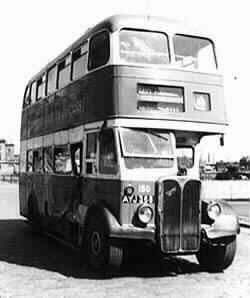
One can forgive the camera shake in this photograph. AYJ 368 (no. 150) has just had an unfortunate accident resulting in serious damage behind the driver's door. The accident must have recently happened, as another photograph shows # a small crowd gathering around the bus. The AEC Regent III was one of a batch of nine fitted with bodies by Barnard Ltd., from far away Norfolk. All the more pity that someone should take a swipe at it. It was withdrawn in 1969.
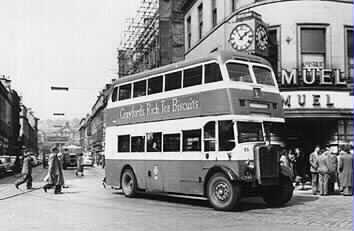
Another of the 1938 oil engine Regents, YJ 5887, chassis number O6615943. Note the interesting lorry following up behind. The cobbles and tram lines are still in place and are much in evidence in these photographs but the trams themselves went in 1956. When built these "oilers" had a more modern looking radiator, the bottom edge being below the dumb irons. All seem to have reverted to short type by this time in their lives.
Iain Drummond said "The photo of YJ 5887 was taken as the bus turned out of Reform Street into High Street. Samuel's clock is in the background. Under the clock was a popular meeting place."
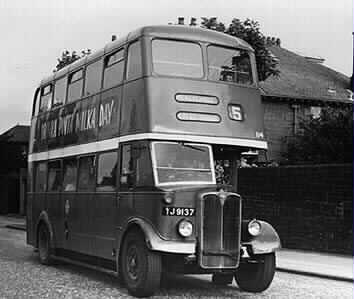
The body on YJ 9137 (no. 64) looks more modern and quite frankly much less appealing. Perhaps it is the effect of the later livery of dark green with one white band (reputed to have been introduced from the end of 1961). The body is an odd design, the old fashioned look to the dash panel suggesting age but the upper deck looking out of place. In fact this was one of a batch of ten Regents (nos. 55-64) delivered at the end of 1948 with MCCW H30/26R bodies. They were withdrawn around 1968. A number of Dundee vehicles were also bodied by Croft who specialized post war in re-bodying older chassis. No. 64 was re-numbered as 114 in 1967, shortly before its retirement.
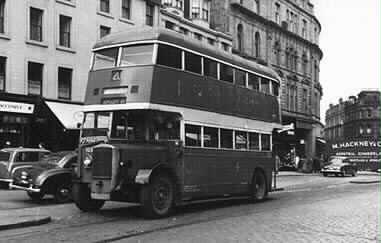
Parked in the middle of the road and displaying "Duplicate" on the blinds, YJ 7054 awaits a tour of duty. In the background an articulated furniture removal lorry is manoeuvering across the street, delaying Dundee's sparse traffic.
Iain Drummond said "YJ 7054 is parked in High Street adjacent to the city square which is to the right of the photo. This had been a timing and changeover point for all tram services except the Lochee route, and this continued with the replacement bus services. YJ 7054 was one of a batch of Daimler COG6s fitted with Dickson bodies. Dickson was a local firm who built several bodies for the Corporation in the 1930s including two on the Leyland Lions. They were in Downfield but I do not know if there was any connection between them and Dickson, the tours operator later taken over by Wallace Arnold."
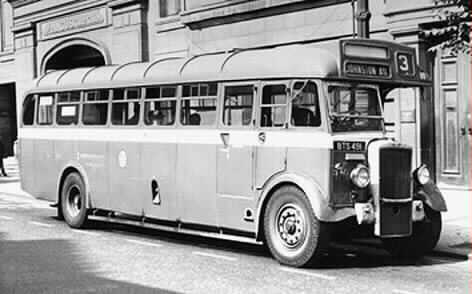
Here, viewed from the off side is Daimler CVD6, BTS 491 (no. 11) one of ten (nos. 8-17) dating from 1951. It was fitted with Brush B39R bodywork to the new 30 feet maximum length. It has had an unfortunate scrape just in front of the rear wheel arch. The last of this batch were withdrawn in the summer of 1968, handing over their duties to AEC Swifts.
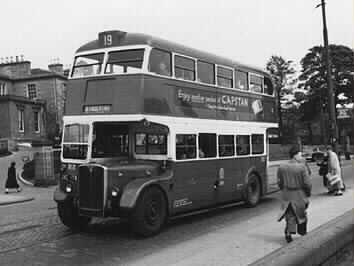
Dundee was famous for taking on Cravens bodied RTs from London Transport. Here JXC 178 (no. 212) looks very smart in the earlier colour scheme. It had been delivered new to London Transport as RT1415 in March 1949. London took delivery of 120 Cravens-bodied RTs but, since their bodies were non-standard (they had five bays instead of the usual four) and somewhat heavy, although well built, they were the first to be withdrawn when passenger numbers began to decline in the mid-1950s. Most were withdrawn in 1956, but readily found buyers elsewhere around the country and Dundee bought 30. This one was retired from Dundee service in 1969. (Peter Marshall says the picture above was taken at Sea Braes on the Perth Road).
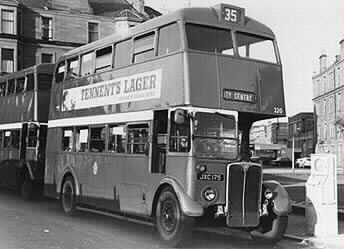
Later in life the Cravens seemed to get a little more bland, particularly without the white around the upper deck windows. This is JXC 175 (no. 220), originally RT1412 with London Transport, delivered new to them in February 1949. Note that the main destination display, previously just painted out, has now been panelled over to give the bare minimum of information. This too adds to the bulky look of the bus. Many of the roof box RTs that went on to further service had their boxes removed altogether so it is nice to see that Dundee made use of theirs. One rather intriguing feature is that some had their cab front panels replaced with a plain panel without the air intake vent which was standard on all London RTs regardless of bodybuilder. From other photographs this is evident on all vehicles that have the revised destination display. No. 220 was withdrawn in early 1969 along with the last of the Cravens-bodied RTs in the Dundee fleet.
David Craig says: "All 30 had the London destination aperture panelled over by about 1960. All the photographs I have of the RTs that have the panelled over display are in the post 1961 livery except one (no. 227) which is in the older livery. As for the air intake vents, I have a photo of 228 in pre 1961 livery, painted over destination display but no air intake vents. I also have photos of 213, 227 and 233 all with panelled over displays but still retaining the vents."
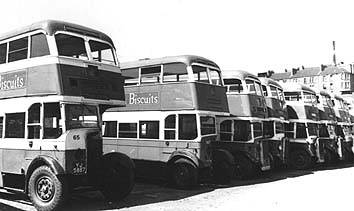
Preservation prospects? The dead vehicle line. Nearest the camera YJ 5887, seen in service in an earlier picture has lost its radiator and a side cover. Bruce Gauld tells us that he thinks this photograph (and the withdrawn AEC Regent above) was probably taken on a piece of waste ground in East Dock Street, possibly near to its junction with Market Street.
Iain Drummond said "The line up of dead buses is at the site of the new Dock Street depot."
David Craig says "The vehicles are in the yard mentioned above (i.e. in the yard in East Dock Street, not the new Dock Street depot) which wasn't near but actually at the junction of East Dock Street and Market Street."
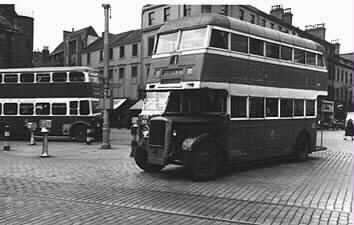
Rather than end on a sad note, here is a picture of the contrasts that could probably be found in most cities in the late fifties. With a modern upstart CVG6 in the background (Bruce Gauld tells us he thinks it is probably an MCCW bodied example on the Downfield route), venerable Daimler COG6, YJ 4116 crosses the recently disused tram lines. This bus was renumbered to no. 155 in 1953, and withdrawn in 1957 so, once again, we have a clue to the approximate date of the photo.
Iain Drummond said "YJ 4116 was one of a batch of Cowieson bodied Daimler COG6s delivered in 1936. The photo was taken after the trams were abandoned and the bus is turning right from Reform Street into the Nethergate. The photographer would have been standing in the City Square and I would reckon it would be late 1956 or early 1957. Cowieson was a Glasgow bodybuilder who had quite a following in Scotland before the war."
David Craig says "YJ 4116 has just turned into High St., not Nethergate."
Iain added "Dundee Corporation crews seemed to lack discipline after the old transport manager retired and Mr. Russell took over in the 1950s. Their accident rate was horrific. I worked for the local Scottish Bus Group operator during the 1950s and the difference between the condition of the buses and the appearance of the crews was very noticeable. Our staff were on a lower pay scale as well."
David Craig says "I would agree with Iain Drummond's comments on the smartness of W. Alexander (the local S.B.G. operator) vehicles and crews compared with the corporation. The stiff brimmed caps worn by Alexander male crews were much smarter than the soft caps used by corporation conductors and drivers. Only corporation inspectors wore stiff caps. Again, only corporation inspector's tunics were of a comparable standard with the tunics worn by Alexander's crews."
As a footnote, a splendid example of a 1950s Dundee bus has been preserved by Mr. B. C. Taylor of Dundee, who bought it on its retirement in 1975. AEC Regent III no. 137 (CYJ 252) was one of seven 8ft wide Regents with 58-seat Alexander bodies purchased by Dundee in 1953. It has been superbly restored in its original livery.
Other survivors of Dundee's earlier days include:
Dundee Corporation Transport was absorbed into the control of the new Scottish regions in 1975, and became Tayside Regional Transport, changing their livery to a striking blue and white.
Email Events diary Past events list Classified ads Links to other websites Classic U.K. Buses Classic Irish Buses Classic Manx Buses